Do AGM Batteries Need to be Vented? (Discover the Truth)

Ever wondered whether AGM batteries need to be vented?
AGM batteries do require venting, but not always. AGM batteries produce less hydrogen gas than other types but can still overcharge and release gas beyond the glass mats’ capacity.
And with that little teaser, i’ll dive deeper into this in the below article.
Venting in AGM Batteries

Do AGM Batteries Need to be Vented
As someone passionate about batteries, I often get asked, “Do AGM batteries need to be vented?”
Let me tell you; it’s a bit of a mixed bag. Some sources say yes, while others say no. From my perspective, it boils down to specific conditions and factors.
Off-Gassing and Hydrogen Production
Now, every battery enthusiast knows they produce hydrogen gas when they charge. Sometimes, this can lead to an explosive situation if not properly vented.
But here’s the scoop: AGM batteries have less off-gassing than their flooded lead-acid counterparts.
This is primarily due to the immobilized electrolyte in AGM batteries, which makes them safer and more environmentally friendly.
However, just because AGM batteries produce less hydrogen gas doesn’t mean they don’t need ventilation.
Overcharging and charging too fast can increase hydrogen production beyond the glass mats’ absorption capacity, potentially leading to a hydrogen explosion.
So let’s go through a quick overview of AGM batteries and their need for venting:
- Less hydrogen gas production than flooded lead-acid batteries
- Immobilized electrolyte makes them safer and more environmentally friendly
- Venting may still be necessary due to hydrogen production when overcharged or charged too fast
Remember friends, whether you’re a DIYer or a professional, always treat your batteries respectfully and understand the nuances of their respective technologies.
Do AGM Batteries Have Vent Holes?

You may wonder if AGM batteries have vent holes, and I’m here to tell you they do! These small vent holes play a crucial role in the overall functionality of the battery.
So let’s jump right in and explore what these vent holes are all about.
First, these vent holes help release excess pressure inside the battery. You see when an AGM battery is charged, it produces hydrogen gas.
This gas can accumulate inside the battery, causing pressure to build up. Vent holes work wonders in relieving this pressure, thus increasing the safety of the battery.
Another interesting fact about AGM batteries is that they can be mounted inside your vehicle. Their unique design allows AGM batteries to be mounted more flexibly than most conventional batteries.
You can easily vent them by connecting thin tubing to the vent holes.
While AGM batteries produce relatively less hydrogen gas as a byproduct than other batteries, it’s still important to vent them.
It’s because they’re still at risk of overcharging or charging too fast. Both conditions can increase hydrogen production beyond what the glass mats can absorb, which can be dangerous.
Ensuring proper venting can help prevent any unpleasant surprises, like a hydrogen explosion.
How to Vent an AGM Battery
if you find yourself in a situation where venting an AGM battery becomes necessary due to a malfunction or damage, extreme caution must be exercised.
It’s highly recommended to consult a professional or contact the battery manufacturer for guidance and assistance. They will provide specific instructions tailored to your battery model and ensure your safety.
In general, here are some steps to follow if you need to vent an AGM battery:
| Step | Description |
|---|---|
| 1. | Evaluate the situation: Assess the need for venting the AGM battery carefully. Only proceed if it is necessary, and take proper safety precautions. |
| 2. | Protect yourself: Wear appropriate personal protective equipment (PPE), such as gloves, safety glasses, and respirators, to protect yourself from potential hazards. |
| 3. | Isolate the battery: Ensure the battery is disconnected from any power sources or equipment. This step is crucial to prevent accidental electrical shocks or short circuits. |
| 4. | Choose a well-ventilated area: Perform the venting procedure in a well-ventilated area, preferably outdoors. Adequate airflow helps dissipate any released gases quickly. |
| 5. | Contact the manufacturer: Before proceeding, contact the battery manufacturer or consult a professional to seek guidance on venting procedures for your AGM battery model. |
| 6. | Follow manufacturer instructions: Follow the specific instructions provided by the battery manufacturer. They may advise against venting or provide a recommended procedure if venting becomes necessary. |
| 7. | Open the battery case: If permitted, carefully open the battery case using appropriate tools or methods as instructed. Be mindful of any warnings or precautions mentioned by the manufacturer. |
| 8. | Ventilation method: The manufacturer may recommend a particular ventilation method, such as a specific fan or ventilation system. Follow their guidelines precisely to ensure proper venting. |
| 9. | Secure the battery: If it is damaged or leaking, take necessary precautions to ensure it is stable and cannot tip over during the venting process. |
| 10. | Monitor the process: Keep a safe distance from the battery while venting. Continuously monitor the situation to ensure the venting process is proceeding as expected. |
It is always best to prioritize safety and seek expert assistance to handle battery-related issues.
Factors Affecting Venting Requirements
| Factors | Venting Requirement |
|---|---|
| Type of Application | AGM batteries charged at high rates can generate more heat, potentially requiring venting to dissipate excess heat. Slower charging rates may not necessitate venting. |
| Size and Capacity | Larger AGM batteries with higher capacities may generate more heat during charging and discharging, increasing the likelihood of venting requirements. Smaller batteries may have lower heat generation and may not require venting. |
| Charging Rate | AGM batteries that are charged at high rates can generate more heat, potentially requiring venting to dissipate excess heat. Slower charging rates may not necessitate venting. |
| Ambient Temperature | High ambient temperatures can accelerate battery heat generation. In such conditions, venting may be necessary to prevent the battery from overheating. Lower ambient temperatures may not require venting. |
It’s important to consult the battery manufacturer’s documentation and industry standards for accurate and up-to-date information on venting requirements.
What Happens if You Don’t Vent an AGM Battery
It’s important to understand the consequences of not venting an AGM battery. I’ve seen a lot of confusion on this, so let’s clear it up.
First off, when AGM batteries are overcharged, they can heat up. What does it mean for us? Well, increased internal pressure, that’s what! And guess what? This may cause the battery to explode.

That’s not something we want on our hands, right?
I know what you’re thinking – AGM batteries absorb hydrogen gas in their glass mats. True, but sometimes our battery can produce more hydrogen than those mats handle.
And with too much hydrogen, we’re back to the risk of explosion. So better safe than sorry, I always say.
Okay, here’s something else you should know. Ventilation isn’t just about safety. It also helps improve your AGM battery’s performance and durability.
That’s a double win if you ask me – protecting us and boosting our battery’s life.
To sum it up, let’s list the main reasons for venting an AGM battery:
- Preventing explosions (nobody wants those!)
- Enhancing performance (because we all love efficiency)
- Extending durability (longer battery life equals more fun adventures)
That said, venting an AGM battery is crucial for safety and performance. It’s a small step that goes a long way. So let’s keep our batteries vented and enjoy the ride!
Signs that AGM Battery Needs to be Vented
So, what are the signs that your AGM battery needs to be vented? I’ve got your back. Here’s a list of things to watch out for:
- Strange Odor: Have you ever caught a whiff of something odd coming from your battery area? That’s a huge red flag. A strange odor might indicate that your AGM battery needs venting.
- Swollen Case: Get your eyeballs on the battery case! If your battery is swelling or bulging, it’s overheating, and it might be time to vent it.
- Overcharging: Charging your AGM battery too fast or leaving it connected to a charger for too long can lead to overcharging. That’s bad news – overcharging increases hydrogen production, which can result in a hydrogen explosion.
Let’s use a table to make it crystal clear:
| Signs of AGM Battery Needing Venting | What to look for |
|---|---|
| Strange Odor | The unusual smell in your battery area |
| Swollen Case | A bulging or swelling AGM battery case |
| Overcharging | A battery charged too quickly or for long |
But if you notice any of these signs, it’s time to take action. Safety first, my friends!
Why is it Important to Vent Batteries
Venting batteries is crucial for safety reasons. When AGM batteries are charged, they produce hydrogen gas, which can accumulate inside the battery case and create pressure.
If this pressure builds up too much, the battery can rupture or even explode, and trust me, that’s something you definitely want to avoid!
Improved safety is one of the biggest benefits of venting these batteries.
You might think, “But AGM batteries are known for low hydrogen gas production, right?” Well, you’re not wrong there! AGM batteries do produce less hydrogen gas as a byproduct.
However, they can still be at risk of charging too fast or overcharging. In either of those situations, hydrogen production can increase beyond what the glass mats can handle, and that’s where things get risky.
So, venting your AGM batteries is still important to prevent explosions.
So, my friends, while AGM batteries may not need as much venting as regular lead-acid batteries, they are still essential for safety.
Don’t forget that you can never be too cautious about hydrogen gas buildup.
Wrapping Up
While AGM batteries produce less hydrogen gas than flooded lead-acid batteries, they still require venting under certain conditions.
The immobilized electrolyte in AGM batteries makes them safer and more environmentally friendly.
However, overcharging or charging too fast can increase hydrogen production beyond the glass mats’ absorption capacity, posing a risk of a hydrogen explosion.
Proper venting is essential to prevent explosions, enhance battery performance, and extend durability.
References
Organizations:
- U.S. Battery. https://www.usbattery.com/
- Battery Council International: https://batterycouncil.org/
Book:
- “Battery Technology Handbook” by H.A. Kiehne
Website:
- Absorbed Glass Mat (AGM) Batteries by Battery University. https://batteryuniversity.com/article/bu-201a-absorbent-glass-mat-agm
Video References
Your Home Garage
The Battery Shop
Kyle Bishop
